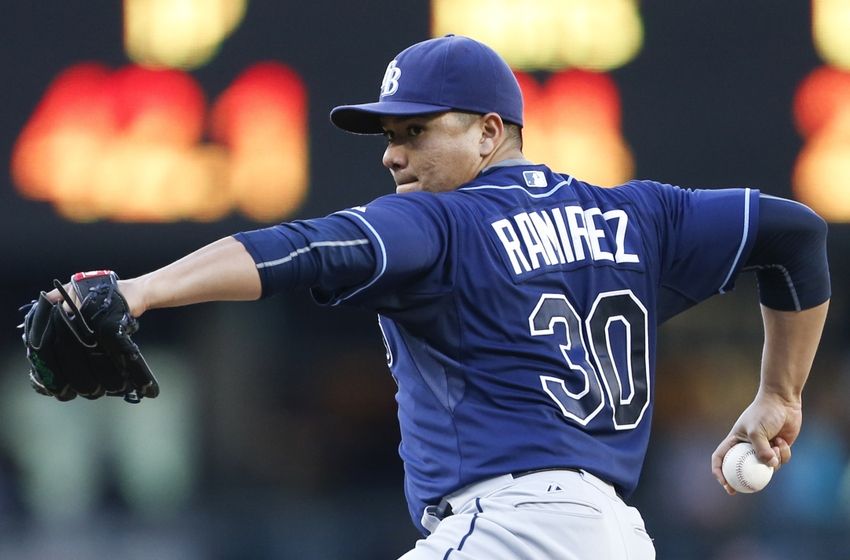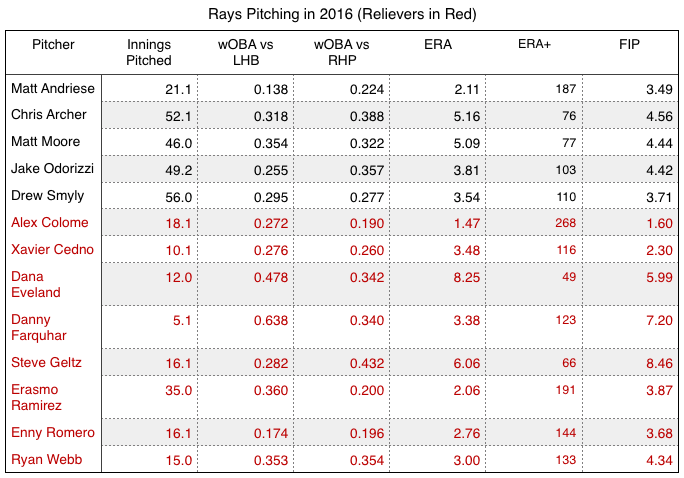
Through 42 games, the Tampa Bay Rays pitching staff has met certain expectations, while lagging in others. A few weeks back we took a look at the Rays offense. Today I’ll take a peripheral look at the pitching staff, in an attempt to determine how Tampa Bay’s hurlers are doing at the quarter point of the season.
First off, let’s define a few terms.
wOBA
Weighted On-Base Average (wOBA) combines all the different aspects of hitting into one metric, weighting each of them in proportion to their actual run value. While batting average, on-base percentage, and slugging percentage fall short in accuracy and scope, wOBA measures and captures offensive value more accurately and comprehensively.
ERA+
ERA+ is a pitching statistic in baseball. It adjusts a pitcher’s earned run average (ERA) according to the pitcher’s ballpark (in case the ballpark favors batters or pitchers) and the ERA of the pitcher’s league. Average ERA+ is set to be 100; a score above 100 indicates that the pitcher performed better than average, below 100 indicates worse than average.
FIP
FIP is a measurement of a pitcher’s performance that strips out the role of defense, luck, and sequencing, making it a more stable indicator of how a pitcher actually performed over a given period of time than a runs allowed based statistic that would be highly dependent on the quality of defense played behind him, for example. Certain pitchers have shown an ability to consistently post lower ERAs than their FIP suggests, but overall FIP captures most pitchers’ true performance quite well.

Matt Andriese has become the dependable pitcher the Rays have needed of late, however, he’s accrued about half as many innings of work as the other starters. On the whole, Drew Smyly has been the best, and most consistent starter, with Jake Odorizzi falling in behind. Matt Moore and Chris Archer have cost the team just over 10 runs more than the average pitcher (when looking at wRAA), according to Jason Hanselman (The Process Report).
Moore and Archer ― along with relievers Dana Eveland and Steve Geltz ― have performed below average when taking ERA+ into consideration. What’s interesting, Eveland has posted even worse numbers than Geltz, yet with the big league squad he remains. I’m not suggesting that Geltz didn’t deserve his demotion, instead t’s my opinion that neither pitcher should be with the Rays. With an 8.46 and 7.20 FIP (respectively), it’s no wonder the team moved both Geltz and Danny Farquhar to Triple-A to work on their stuff.
In spite of his performance Monday night — which could be due to overuse — Erasmo Ramirez has been the bright spot in the bullpen, all while facing the toughest opposition of any pitcher on the team. He has worked fewer innings than the starters, yet he’s appeared in 9-1/3 high-leverage innings and managed a .077 BA/.207 OBP/.080 SLG/.287 OPS/.166 wOBA line against. Erasmo’s covered multiple innings while stifling the opposition for the most part. A caveat, Kevin Cash would be wise not to use Ramirez for extended outings out of the ‘pen; overuse may hamper his production down the road.
Regardless of outcome, not a fan of #Rays Ramirez starting the 8th with his workload
— Neil Solondz (@neilsolondz) May 24, 2016
Despite a few blips with command, Enny Romero has shown that he can be effective against both lefties and righties. With a little more polish, he could be an apt replacement for Jake McGee. His right-handed counterpart, Alex Colome, has shown to be excellent in the closer’s role. Colome leads the team in ERA+ and FIP, and his 11/11 in save opportunities puts him in esteemed company with the likes of Wade Davis, Zach Britton, and Ryan Madson.
I didn’t focus on wRAA, however, Hanselman did in a recent piece. He found that in spite of the recent pitching woes by the starting rotation, the team has been pretty good overall.
Overall, the pitching has been around 16.5 runs better than average, and that goes even higher when taking into account the types of hitters the Rays have faced as they’re beating those expectations by nearly 19.5 runs. The team has owned lefties and righties alike, but special emphasis should be on the latter as it looks like they have faced a well above average complement of right-handed batters.
…Beware of those who say it’ll be okay
While there have been successes on the mound, the mounting failures of the pitching staff have proven costly for a team that’s scored four or more runs consistently over the last month. And while Matt Silverman assembled a team with more thump, he did not do so to cover for a pitching staff that has shown cracks.
Monday marked 18th time in 42 games a Rays starter did not get past five innings. As Marc Topkin (Tampa Bay Times) put it, it was the 24th time* the team didn’t get a quality start (six or more innings, three or fewer runs).
The bullpen could also use at least another dependable reliever, above and beyond Brad Boxberger, who’s slated to return next week. Suffice it to say, the “C” ‘pen composed of Webb, Eveland and the now-departed Geltz have not shown to be trustworthy in high leverage situations. Credit where it’s due, Webb strung together a pretty good three-inning outing on Sunday. Because he hasn’t shown much-to-any improvement, Eveland, who’s given up 11 runs in 12 innings of work, appears to be the likeliest candidate to befall the ax in some capacity when Boxberger returns.
Conclusion
While there have been a few bright spots for the Rays pitching staff, overall something must be done to patch the cracks before the foundation becomes compromised. The fact remains, if the Rays are going to be a relevant team past the summer, they cannot continue as a middling .500 team. It’s up to the hurlers, both starters and relievers, to tighten up and become the dominant staff they were projected to be.
*Now the 25th time as of Monday
